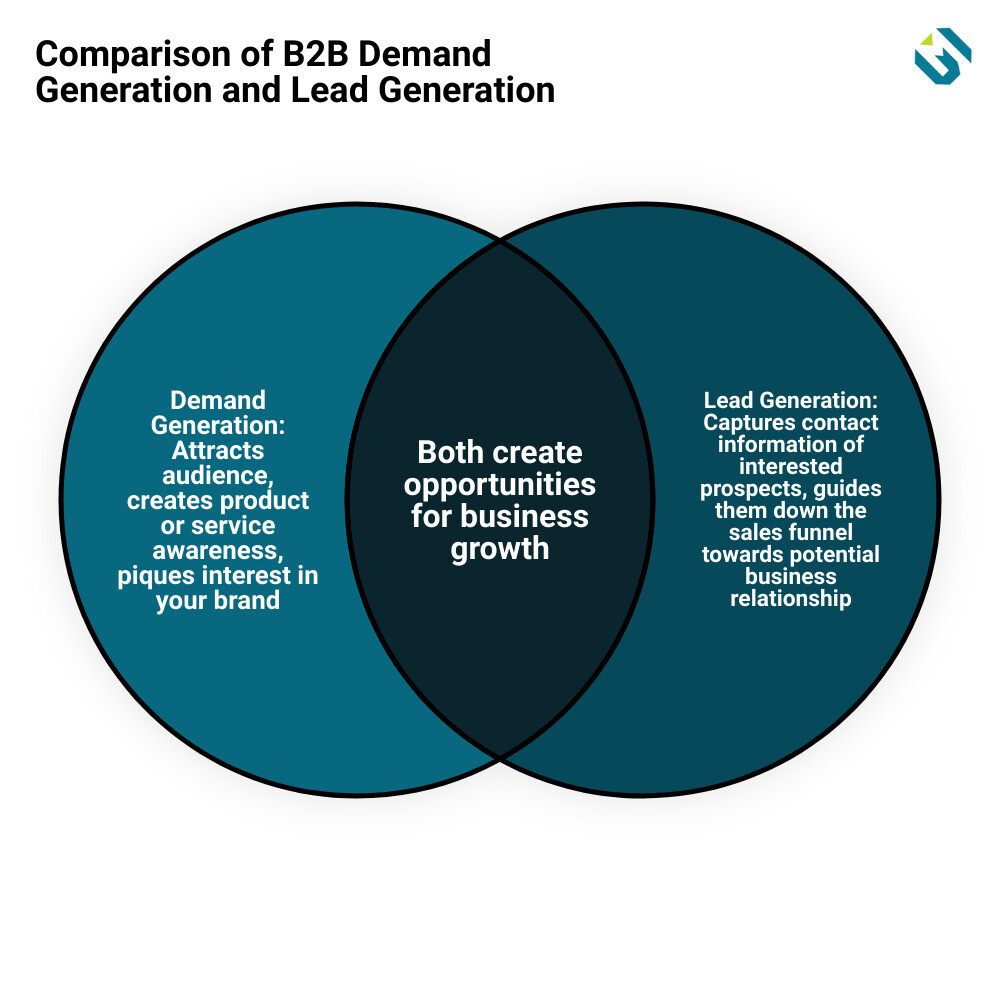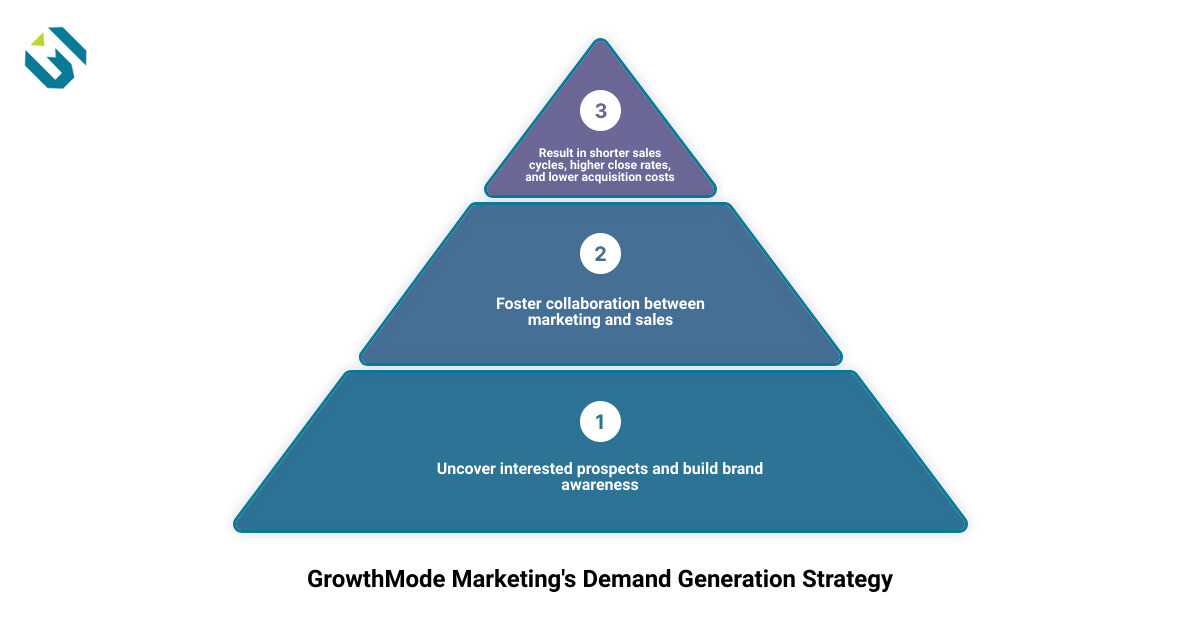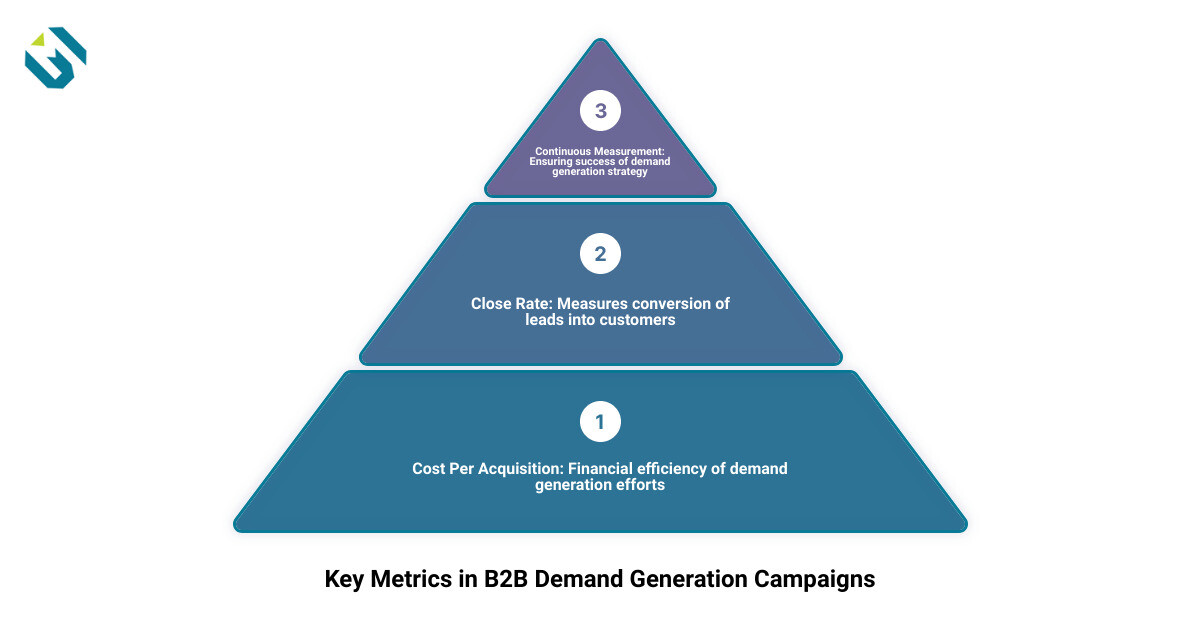This article was written by AI and is unedited. We are testing the technology to determine results.
In the fiercely competitive world of B2B marketing, the ability to generate demand for your products or services can spell the difference between exponential growth and stagnation. B2B demand generation campaigns are crucial tools for driving business growth, amplifying brand visibility, and improving the quality of leads. But the untapped potential for explosive growth lies in knowing how to unleash the power of these campaigns to your advantage.
At GrowthMode Marketing, we help companies navigate the complexities of B2B demand generation, transforming the cluttered market into a landscape of opportunities. We understand the challenges you face and have crafted strategies to help you stand out, attract your ideal customer profile audience, and create a steady pipeline of high-quality leads.
As we delve deeper into the subject, it’s important to highlight that the terms ‘demand generation’ and ‘lead generation’ are not interchangeable. While interconnected, they serve different functions and require distinct strategies. In essence, demand generation creates the initial interest, while lead generation converts that interest into potential business opportunities.
Quick Snapshot of B2B Demand Generation versus Lead Generation:
- Demand Generation: Attracts audience, creates product or service awareness, and piques interest in your brand.
- Lead Generation: Captures contact information of interested prospects, and guides them down the sales funnel towards a potential business relationship.
In the coming sections, we’ll explore proven B2B demand generation strategies that can skyrocket your growth trajectory, delve into the role of content and account-based marketing, and reveal how partnering with a demand generation agency like GrowthMode Marketing can give you a competitive edge.
The Role of Demand Generation in B2B Marketing
In the dynamic and competitive world of B2B marketing, demand generation plays a pivotal role in standing out and driving growth. But what exactly is demand generation, and why is it so important?
Definition and Importance of Demand Generation
B2B demand generation can be defined as a strategic marketing approach aimed at creating interest and awareness for a product or service. It involves identifying and understanding the target audience, developing valuable content that addresses their problems, and nurturing them until they convert into customers. This process is not just about generating immediate sales but also about cultivating long-term relationships with potential customers, a game-changer for businesses that aids in acquiring and retaining customers.
A robust demand generation strategy serves as a lighthouse, attracting and guiding your target audience towards your brand. It’s about positioning your brand as a solution to the potential customer’s needs and problems. In essence, a successful demand generation strategy does not just cast a wide net in the hope of catching a few interested parties, it is a tailored approach that identifies and attracts the most relevant customers, leading to the generation of high-quality leads with an increased likelihood of conversion.
At GrowthMode Marketing, we view demand generation as the epitome of targeted marketing. When executed correctly, it can result in shorter sales cycles, higher close rates, and lower customer acquisition costs, which translates into sustainable growth for your organization.
Key Performance Indicators for Demand Generation
When it comes to determining the success of your B2B demand generation campaigns, it’s vital to track key performance indicators (KPIs). These metrics help you gauge whether your efforts are hitting the mark and driving the desired results.
One critical KPI to monitor is the percentage of closed sales, which indicates how many of your leads are converting into customers. Conversion rates throughout the sales funnel, Cost Per Acquisition (CPA), Cost Per Lead (CPL), and the volume of qualified leads are also vital metrics.
Two additional important KPIs include the average dollar value per deal, which shows the average revenue generated per closed sale, and Customer Lifetime Value (CLV), which indicates the total revenue a business can reasonably expect from a single customer account.
These metrics provide a comprehensive view of the effectiveness of your demand generation strategies. If these tactics are working, you should see a decrease in your cost per acquisition and cost per lead, along with significant improvements in the other metrics.
In the next section, we will delve deeper into proven B2B demand generation strategies that can help your business achieve explosive growth.
Unveiling the B2B Demand Generation Strategies
Let’s pull back the curtain on the essential B2B demand generation strategies that can help your business achieve unprecedented growth. These strategies are not static; they evolve with the ever-changing digital marketing landscape. But fret not, we’re here to help you navigate these changes and implement strategies that will catapult your demand generation services.
Improving the Demand Funnel Framework
Firstly, it’s important to generate demand at each stage of the sales funnel. Your marketing and advertising campaigns should capture people at various stages, from discovery to conversion. By creating prospecting campaigns targeted at your key audiences, you can create awareness of your product or service. Then, use your CRM data to run mid-funnel ABM campaigns and your pixel data to retarget those potential customers who explored your site, but have yet to convert.
Integrating CRM and Marketing Automation
Next, integration of CRM and marketing automation is key. CRM involves collecting and organizing customer information, from leads to existing customers, and tracking every interaction they have with your company. By adding marketing automation to your CRM data, you can ensure consistent engagement with interested leads and guide them through the funnel. This approach helps optimize sales pitches and follow-up meetings, personalizing the experience for potential customers.
Optimizing Lead Nurturing
Optimizing your lead nurturing process is crucial. Your marketing team should assist your sales team throughout the process, creating content that answers customer questions and moving individual leads through the sales pipeline. If a potential customer is considering your product but hasn’t scheduled a meeting with a sales rep, your demand generation content could be the push they need to schedule a demo.
Refining Lead Scoring
Refining lead scoring is another essential step, requiring you to consider not only website interactions but also social media engagement, email engagement, and website analytics. By compiling this information, you can create a matrix that helps better qualify leads and develop B2B demand generation tactics that resonate with each specific prospect.
Using Account-Based Marketing
Account-Based Marketing (ABM) allows you to personalize campaigns based on each account’s specific needs and characteristics. With the help of the CRM data, you can hone in on specific messaging for a lead or group of leads. This strategy aids in having more personalized and effective conversations with potential customers.
Developing a Content Strategy
Content is the backbone of B2B demand generation. It provides details about your product or service and how potential customers can use it to improve their business. When developing your content strategy, prioritize content based on the lead score. Create a range of content, from general prospecting to answering specific commonly asked questions, aimed at creating a need for your product or service.
Leveraging Social Media
Over half of marketers specializing in B2B strategies have generated leads from their social media feeds. Refine your social media strategy to improve your demand generation tactics. By engaging with your audience on social media with personalized content, you can create demand for your products or services.
Enhancing Email Marketing Efforts
Email marketing remains a powerful tool in demand generation. By sending targeted messages based on the recipient’s stage in your pipeline, you can guide them through the funnel, offering supplemental information to those in the exploratory phase, or reminders to those on the brink of conversion.
Building Authority with Event Marketing
Hosting webinars and online events can establish your reputation as a thought leader. These platforms allow you to share valuable content that adds value to your audience’s organization, leading to increased engagement and a stronger relationship with your audience.
Using Performance TV Advertising
Finally, Performance TV Advertising can supplement your sales techniques with marketing strategies designed to educate customers about your business and create demand.
By incorporating these strategies into your B2B demand generation efforts, you can improve your audience engagement, brand exposure, and ultimately, your lead generation. Whether it’s leveraging intent data, enhancing email marketing efforts, or hosting webinars, each strategy plays a vital role in enhancing your demand generation services, setting the stage for business growth.
Next, we’ll delve into the role of content in B2B demand generation.
The Power of Content in B2B Demand Generation
As we dive deeper into the core of B2B demand generation campaigns, one cannot overlook the power held by content. It’s the heartbeat of any successful demand generation strategy, acting as the bridge between awareness and conversion. When meticulously crafted, content can lead to a seismic shift in the perception of your brand, accelerating growth potential.
Building Brand Awareness through Content
In the bustling B2B landscape, brand awareness is not merely about getting your name out there. It’s about creating an enduring, positive impression that makes your company the go-to solution when potential buyers encounter relevant challenges. As Samantha Bonanno from Gartner highlights, a robust demand generation program builds brand awareness and authority, and produces thoughtful, engaging content that drives interest and cultivates leads.
Customer reviews are an effective tool for building brand awareness. These authentic, peer-provided summaries give prospective clients a snapshot of real-world product usage, free from any marketing hype. By prioritizing and encouraging customer reviews, you can increase your visibility and credibility in the market.
Establishing Industry Expertise
Building industry expertise goes hand-in-hand with brand awareness. When potential customers perceive your brand as an authority in its field, it builds trust and sets the foundation for meaningful conversations about their pain points and how your solutions can address them.
A solid content marketing strategy that offers timely, helpful insights at each step of the purchase journey is the best way to build expertise. Content that answers buyer questions and concerns as they traverse their purchase journey not only builds purchase confidence but also solidifies your brand’s credibility.
Cater to specific, high-value leads by developing curated or personalized content that addresses their specific needs. This will guide them through their purchase and anticipate common questions and concerns, making your brand a trusted guide within the marketplace.
Nurturing High-Quality Leads with Content
High-quality content is the cornerstone of a cost-effective growth strategy. As we at GrowthMode Marketing note, content marketing can generate three times more leads at a cost that’s 62% less than outbound marketing activities. This is because content that’s tailored for each stage of the buying journey has staying power. As your audience engages with your content at multiple stages, you begin to build their interest, trust, and loyalty through content that demonstrates your expertise.
By consistently providing an expanding pipeline of high-quality content, your lead pipeline grows along with your content library. Your cost-per-lead decreases as you continue to develop more engaging content because your existing content continues to work as a lead generator. In a nutshell, great content is a key asset that can drive long-term growth for your company.
It’s clear that content plays a pivotal role in B2B demand generation, helping to build brand awareness, establish industry expertise, and nurture high-quality leads. As such, it should play a central role in any B2B growth marketing strategy.
The Rise of Account-Based Marketing in B2B Demand Generation
As you navigate through the bustling market, focusing your efforts on laser-targeted strategies can be your game-changer. One such strategy is Account-Based Marketing (ABM), a powerhouse in B2B demand generation which has been gaining momentum significantly.
Understanding Account-Based Marketing
Account-Based Marketing is a tailored strategy where your marketing and sales teams collaborate to target a select group of accounts that represent substantial growth opportunities for your business. These could be potential clients most likely to convert or those ready to invest a significant amount with your company. ABM is like creating a personalized marketing campaign for each of your high-value leads, requiring a deep understanding of these accounts, their unique needs, and their common pain points.
ABM is not a standalone strategy but rather a potent amplifier to your existing demand generation efforts. By targeting the right leads with the right content at the right time, ABM can significantly boost your conversion rates and improve your ROI, contributing to your company’s bottom line.
The Benefits of Account-Based Marketing
ABM is a highly effective strategy for B2B demand generation campaigns. This approach can help clarify and align marketing and sales efforts, leading to more efficient use of resources and a higher chance of closing deals. By focusing on a select group of high-value leads, companies can provide a more personalized, effective experience for potential customers.
Moreover, this strategy allows for a deeper understanding of the key accounts, which can lead to better customer relationships, higher customer satisfaction, and ultimately, increased revenue. As noted by Gartner, ABM can set teams up for success, especially when there are reliable leads trickling in from demand gen strategies.
Implementing Account-Based Marketing in Your Strategy
To integrate ABM in your B2B demand generation strategy, start by creating target personas based on your high-value leads. These personas should embody the business objectives and values these leads share. Understanding the major steps in their buying journey preceding a purchase is crucial.
Following this, guide your marketing efforts using these personas. Provide personalized content that directly addresses their unique pain points and questions. This could be in the form of blog posts, white papers, webinars, or even personalized emails. The end goal is to guide these high-value leads through their purchasing journey, addressing their concerns at each step, and positioning your brand as the go-to authority in your field.
At GrowthMode Marketing, we specialize in demand generation for HR tech and workforce tech companies. We understand the unique challenges and opportunities in this industry. Our team can help identify your high-value leads, create targeted personas, and develop personalized content strategies that drive results.
In the next section, we will delve deeper into how GrowthMode Marketing uses demand generation tactics to drive growth for our clients. Stay tuned!
Partnering with a Demand Generation Agency: The GrowthMode Marketing Advantage
In the crowded HR tech market, standing out can be a herculean task. This is where we, at GrowthMode Marketing, come in. We don’t just bring prospects into the sales process. Instead, we make prospects bring businesses into their buying process.
The Unique Selling Proposition of GrowthMode Marketing
We’re not just another marketing agency. We have a distinct focus on B2B companies, especially in the tech sector. We aim to help these businesses break through the clutter to build brand awareness, gain trust, and ultimately uncover interested prospects.
Our unique selling proposition lies in our demand generation powerhouse. Our strategic, high-impact initiatives result in shorter sales cycles, higher close rates, and lower customer acquisition costs. We’ve transformed the way HR tech companies approach lead generation, replacing traditional methods with demand generation strategies that result in better quality leads and bigger growth for the organization.
How GrowthMode Marketing Bridges the Gap Between Marketing and Sales
At GrowthMode Marketing, we understand that marketing and sales are two sides of the same coin. Both are responsible for growth and should not operate in silos. We use demand generation as a catalyst for growth, fostering a collaborative environment where both marketing and sales work together towards a common goal.
In our podcast, The Demand Gen Fix, we provide valuable insights into the world of demand generation and B2B marketing strategies. We encourage HR tech marketers to look at demand generation as a long-term strategy that can help their organizations achieve sustainable growth.
The Impact of GrowthMode Marketing on HR Tech and Workforce Tech Companies
Our commitment to our clients is unwavering. We are not afraid to push back when our clients lose sight of their mission and focus. We ensure that all marketing efforts align with the client’s ideal customer profile and overall business goals. By providing a clear strategic direction and keeping an eye on the ball for our clients, we have successfully bridged the gap between marketing and sales, helping HR tech companies achieve their growth goals.
Partnering with us can help HR tech and workforce tech companies navigate the complex demand generation landscape. With our expertise and proven strategies, we can help your business stand out, attract high-quality leads, and achieve explosive growth. Stay tuned for the next section, where we delve into how to measure the success of your B2B demand generation campaigns.
Measuring the Success of Your B2B Demand Generation Campaigns
“If you can’t measure it, you can’t improve it,” Peter Drucker famously said. This adage holds especially true for B2B demand generation campaigns. At GrowthMode Marketing, we believe that the effectiveness of your demand generation strategy is only as good as the results it delivers. Therefore, tracking and measuring your efforts is not an option, it’s a necessity.
Importance of Tracking and Measuring Demand Generation Efforts
There’s no point investing in demand generation strategies if you’re not tracking their success. You need to know whether your efforts are paying off, and if not, what needs to be adjusted. By consistently monitoring your campaigns, you can make data-driven decisions, optimizing your strategies for better results and maximum ROI.
Let’s dive into the key metrics that are crucial for assessing your demand generation success.
Key Metrics for Demand Generation Success: Website Traffic, Lead Generation, and Conversion Rates
When it comes to demand generation, not all metrics are created equal. Vanity metrics such as page views and social media followers might feel good, but they don’t necessarily translate into business growth. Instead, focus on metrics that directly tie to your bottom line.
Content Performance: This metric encompasses user behavior, engagement with your content, and overall traffic and SEO performance. Understand which content resonates with your target audience and drives engagement. For instance, at GrowthMode Marketing, we frequently publish blogs, informative e-books, and relevant case studies to educate our customers. This strategy not only helps us inform our customers but also helps us gain a first-page position on search results.
Inbound Leads: Track the prospect information coming in through inbound channels, such as your website. This metric can provide insights into the success of your content and SEO strategy.
Sales Qualified Leads (SQL): SQLs are leads deemed ready to move into your sales process. They have shown a higher level of interest and engagement, making them more likely to become customers. The number of SQLs is a clear indicator of the effectiveness of your lead nurturing efforts.
Close Rate: This measures the number of leads that convert into customers. This metric is a clear indicator of the effectiveness of your sales process and the quality of your leads.
Cost Per Acquisition (CPA): CPA calculates the total cost to acquire one paying customer on a campaign or channel level. This number helps you understand the financial efficiency of your demand generation efforts.
In conclusion, measuring your demand generation efforts is a continuous process. By measuring your success and leveraging the right tools, you can ensure your demand generation strategy is always on the path to success.
In the next section, we’ll wrap up our discussion on B2B demand generation campaigns by looking at the future trends in this space. Stay tuned!
Conclusion: The Future of B2B Demand Generation Campaigns
As we take a glimpse into the future, the digital landscape of B2B marketing is set to shine brighter than ever. The industry is evolving at an impressive pace, and innovative demand generation strategies are poised to shape the growth trajectory of companies operating in this space, especially those in the HR tech and workforce tech industry.
Demand generation in the B2B sector is becoming even more data-driven and integrated. This means that companies will need to invest further in understanding their target audience, creating valuable content, and leveraging the power of SEO, PPC, and social media to reach their ideal customers. This trend is further propelled by the shift towards digitization, flexibility, and hybrid work environments, which have made the need for companies to leverage the power of B2B demand generation services more important than ever.
At GrowthMode Marketing, we have demonstrated that a well-executed demand generation strategy can not only attract the right audience but also convert them into loyal customers. By blending strategy, messaging, PR, content marketing, and digital marketing, we have successfully bridged the gap between marketing and sales, driving unprecedented growth for our clients.
However, it’s important to remember that demand generation is not a one-time strategy. It requires constant nurturing and optimization to keep pace with the changing market dynamics. This makes it crucial for companies to stay agile, adapt their strategies, and continue to invest in demand generation to sustain their growth in the long run.
In conclusion, the future of B2B demand generation services is promising. With the right strategy, tools, and partners like GrowthMode Marketing, companies can navigate the complexities of the market, stand out from the competition, and propel their growth. In the world of B2B marketing, the power of demand generation is not just a trend, but an essential strategy for success.
Your future in the digital B2B marketplace is only as bright as your demand generation strategy. So, make sure you’re shining brightly with a robust, data-driven demand generation approach that drives business growth and success. After all, as we often say at GrowthMode Marketing, the goal is not just to generate leads but to attract quality leads that are more likely to convert into customers, maximizing your ROI.
With the right demand generation campaigns and a steadfast commitment to refining and adapting your strategies, your company can truly unleash the hidden potential for explosive growth.







